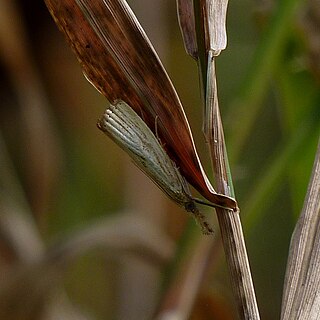Related Research Articles

The Pyraloidea are a moth superfamily containing about 16,000 described species worldwide, and probably at least as many more remain to be described. They are generally fairly small moths, and as such, they have been traditionally associated with the paraphyletic Microlepidoptera.

Florida is a state located in the southeastern region of the United States. With a population of over 21 million, Florida is the third-most populous and the 22nd-most extensive of the 50 United States. The state is bordered to the west by the Gulf of Mexico, to the northwest by Alabama, to the north by Georgia, to the east by the Atlantic Ocean, and to the south by the Straits of Florida. The state's capital is Tallahassee and its most populous municipality is Jacksonville. The Miami metropolitan area, with a population of almost 6.2 million, is the most populous urban area in Florida and the seventh-most populous in the United States. Other urban areas in the state with a population of more than one million are Tampa Bay, Orlando, and Jacksonville. Florida's $1.0 trillion economy is the fourth-largest of any U.S. state, and if it were a country, Florida would be the 16th-largest economy in the world.
Portentomorpha is a genus of moths of the family Crambidae. It contains only one species, Portentomorpha xanthialis, which is found from Texas to Louisiana and Florida, the West Indies and from Mexico to Bolivia.

Fissicrambus mutabilis, the changeable grass-veneer or striped sod webworm, is a moth of the family Crambidae. It is found from Quebec to Florida, west to Texas and Illinois and north to Ontario.

Agriphila vulgivagellus, the vagabond crambus or vagabond sod webworm, is a moth of the family Crambidae. It is found from Quebec and New England to Florida, west to Texas and north to Alberta.

Urola nivalis, the snowy urola moth, is a moth of the family Crambidae. It is found from southern Canada and Maine, south to Florida and west to Illinois and Texas.

Scopariinae is a subfamily of the lepidopteran family Crambidae. The subfamily was described by Achille Guenée in 1854.

Parapediasia decorellus, the graceful grass-veneer, is a moth in the family Crambidae. It was described by Zincken in 1821. It is found in North America, where it has been recorded from Alabama, Arkansas, Florida, Georgia, Illinois, Kansas, Maine, Maryland, Massachusetts, Missouri, New Hampshire, New Jersey, New Mexico, North Carolina, Ohio, Oklahoma, South Carolina, Tennessee and Texas.
Undulambia fovecosta is a moth in the family Crambidae. It is found in Panama, Guatemala and Costa Rica.
Cangetta micralis is a moth in the family Crambidae. It is found in South America, the Caribbean and in southern Florida.
Cnaphalocrocis cochrusalis, the marasmia moth, is a moth in the family Crambidae. It is found in the West Indies, Costa Rica, Honduras and the United States, where it has been recorded from Florida, Louisiana, Mississippi, Oklahoma, South Carolina and Texas.
Microthyris lelex is a moth in the family Crambidae. It was described by Pieter Cramer in 1777. It is widespread in the Caribbean, Central America and northern South America. Records include Suriname, Puerto Rico and Jamaica. It has recently been recorded from southern Florida.
Diacme mopsalis, the mopsalis diacme moth, is a moth in the family Crambidae. It was described by Francis Walker in 1859. It is found in South America, Central America, the Antilles and the southern United States, where it has been recorded from Arizona, Florida, Oklahoma and Texas.

Diastictis argyralis, the white-spotted orange moth, is a moth in the family Crambidae. It was described by Jacob Hübner in 1818. It is found in North America, where it has been recorded from Colorado, Florida, Georgia, Indiana, Maine, Maryland, Mississippi, North Carolina, Ohio, Ontario, South Carolina, Tennessee, Texas and Virginia.
Glyphodes floridalis, the Florida milkweed vine moth, is a moth in the family Crambidae. It is found in North America, where it has been recorded from Florida.
Leucochroma corope is a moth in the family Crambidae. It was described by Stoll in 1781. It is found from the West Indies and Central America to South America. It is an introduced species in Florida.
Microphysetica hermeasalis is a moth from the family Crambidae. The moth was discovered by Francis Walker in 1859, and it is found in Venezuela, Mexico, Central America, the Antilles and Florida. Its wingspan is 9–10 mm. Adults are on wing from March to June and from November to December in Florida.
Penestola bufalis, the black penestola moth, is a moth in the family Crambidae. It was described by Achille Guenée in 1854. It is found in the US states of Texas and Florida, as well as on the Antilles. It is an accidentally introduced species on the Galápagos Islands. The habitat consists of coastal mangrove swamps and shorelines.
Samea druchachalis is a moth in the family Crambidae. It is found in Mexico and the southern United States, where it has been recorded from Florida and Texas.
Sathria internitalis is a moth in the family Crambidae. It is found in Haiti, the Dominican Republic, Cuba and Florida.
References
- ↑ "global Pyraloidea database". Globiz.pyraloidea.org. Retrieved 2014-07-15.
- ↑ BOLD Systems
- ↑ mothphotographersgroup
| This Omiodes-related article is a stub. You can help Wikipedia by expanding it. |